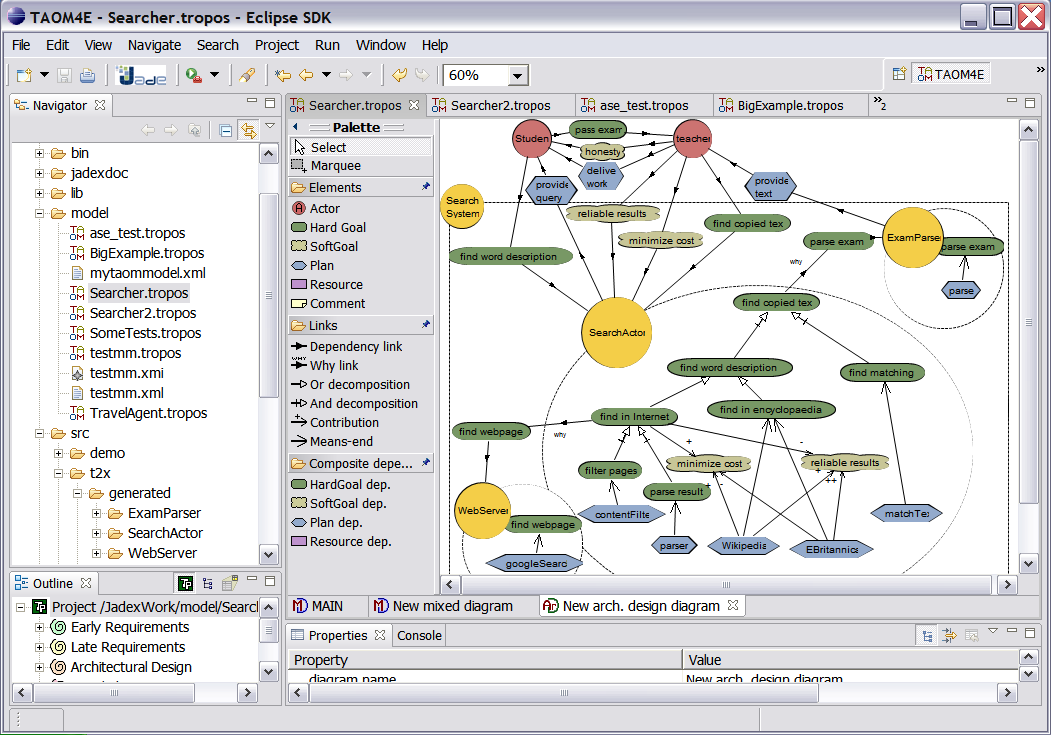TAOM4E
Table of contents
- TAOM4E
- General Information
- i* Modelling Suitability
- 1. Does the tool allow SD modelling?
- 2. Does the tool allow SR modelling?
- 3. Does the tool allow working with SD & SR models jointly?
- 4. Does the tool allow the construction of the models graphically?
- 5. Does the tool allow the construction of the models textually?
- 6. Describe how the elements are modelled and their flexibility (i.e., the elements can be moved and reordered).
- 7. Describe how the dependency links are modelled and their flexibility (i.e., dependencies are modelled with straight lines that can not be redirected).
- 8. Does the tool allow automatic organization of the elements?
- 9. Other modelling facilities provided by the tool:
- 10. Does the tool check SD models?
- 11. Does the tool check SR models?
- 12. Other checks provided by the tool (i.e., cross validation between SD and SR models).
- 13. Does the tool allow working with two or more models at the same time?
- 14. Does the tool allow to group models in projects?
- 15. Does the tool allow working with two or more projects at the same time?
- 16. What are the other functionalities that the tool provides?
- Usability
- Maturity of the Tool
- 22. Rate the maturity of the tool from the user point of view:
- 23. Has the tool been used for any case study?
- 24. Has the tool been tested in large models?
- 25. Has the tool any drawback when working with very large models?
- 26. Which is approximately the maximum size of the model (in terms of actors and dependencies) the tool has been used for?
- Extensibility and Interoperability
- 27. Does the tool allow importing files?
- 28. Does the tool allow exporting files?
- 29. Does the tool allow importing/exporting data through an XML format?
- 30. Is the architecture of the tool published?
- 31. Does the tool allow the addition of other elements outside the i* framework of the tool?
- 32. New functionalities can be added to the tool by means of:
- 33. Rate the maturity of the tool from for open development:
- 34. Is there any internal documentation for programmers?
General Information
Tool Name
TAOM4E - Tool for Agent Oriented visual Modeling for the Eclipse PlatformVersion
0.6.3Group
Software Engineering group, http://se.fbk.eu/, FBK Center for information Technology, Trento, ItaliaWeb page
http://selab.fbk.eu/taom/Main Purpose of the Tool
TAOM4E supports a model-driven, agent oriented software development and, in particular, the Tropos methodology. It has been designed taking into account Model Driven Architecture (MDA) reccomandations.i* framework supported
Tropos methodologyAvailability of the tool
- ( ) For i* modelling only
- ( ) For development only
- (X) Both
Programming Language
JavaPlatform Requirements
Any platform (Eclipse plug-in)Other technology needed
- JDK - Java
- Eclipse Platform
Current state of the tool
Working version is available for download on the website. Automated installation with dependency resolution through the Eclipse update manager.Ongoing work
Extending the tool with later phases of Tropos methodology, providing support of the Tropos process, integrations with different reasoners, improving and extending the usability and the functionalities.i* Modelling Suitability
1. Does the tool allow SD modelling?
Yes2. Does the tool allow SR modelling?
Yes3. Does the tool allow working with SD & SR models jointly?
YesIf so, please specify how (i.e., by means of expandable elements).
The actor elements can be expanded with the balloons containing the SR diagrams.
4. Does the tool allow the construction of the models graphically?
YesIf so, please specify how (i.e., dragging and dropping the elements into a drawing page).
Dragging and dropping the elements into a drawing page from the palette or from the model tree.
5. Does the tool allow the construction of the models textually?
NoIf so, please specify how (i.e., filling a dependency table).
6. Describe how the elements are modelled and their flexibility (i.e., the elements can be moved and reordered).
Users can change the name, size, color and font of an element. The element can also be moved, reordered, deleted, copied, pasted, highlighted, and labelled a symbolic attribute. All these actions are done graphically and by commands either on the menu bar or pop-up command window. One model element can be visualized on many diagrams. Different, partial views of a model can be represented in a diagram.7. Describe how the dependency links are modelled and their flexibility (i.e., dependencies are modelled with straight lines that can not be redirected).
The link can be moved, reordered, copied, pasted, and highlighted. The link can be rediredcted but can not be curved.8. Does the tool allow automatic organization of the elements?
No9. Other modelling facilities provided by the tool:
- uno/redo of all the modelling actions
- copy and paste of groups of elements
- drag and grop of model elements from the model tree to a diagram
10. Does the tool check SD models?
NoIf so, please specify how (i.e., the tool checks if all the SD dependencies are assigned).
11. Does the tool check SR models?
Yes, modelling is restricted by the underlying Tropos meta-model.If so, please specify how (i.e., checks if the SR links are correctly stated).
12. Other checks provided by the tool (i.e., cross validation between SD and SR models).
No, but mixed SD/SR models are available.13. Does the tool allow working with two or more models at the same time?
YesMore models and more views on one model.
14. Does the tool allow to group models in projects?
YesThe functionality is provided by the Eclipse Platform. One *.tropos file can contain many diagrams related to the same model.
15. Does the tool allow working with two or more projects at the same time?
Yes, The functionality is provided by the Eclipse Platform.16. What are the other functionalities that the tool provides?
- the diagrams can be exported to jpg, png, bmp and eps format pictures
- the visual properties of a model like color, font, the type of the lines and them width can be exported and imported to other models
- Eclipse Platform provides us the easy integration with additional plug-ins
Usability
17. Rate the understandability of the user interface
- ( ) Internal use
- (X) Ready for public use
- ( ) Has been used publicly
- ( ) not in English
- ( ) writing not polished
- ( ) poor usability (colours, ...)
- ( ) others: please specify
18. Rate the quality of the user manual
- ( ) Inexistent
- (X) Internal use
- ( ) Ready for public use
- ( ) Has been used publicly
- ( ) incomplete
- ( ) obsolete
- ( ) not in English
- ( ) writing not polished
- ( ) others: please specify
19. Does the tool provides i* learning facilities?
NoIf so, explain which ones (i.e., methodological guidance).
20. Does the tool provide any examples for the users?
Yes. Here you can see the screencam movie showing how to use TAOM4E for building a Tropos model (for the version 0.1.5)21. Rate the difficulty of installing the tool
- ( ) Copy files and initializing paths
- ( ) Copy files
- ( ) Executable installation file provided
- (X) Installation through the Eclipse Update Manager
Maturity of the Tool
22. Rate the maturity of the tool from the user point of view:
- ( ) Under Development
- ( ) Prototype
- (X) Ready for public use
- ( ) Has been used publicly
- ( ) incomplete
- ( ) occasional testing
- ( ) non-exhaustive testing
- ( ) non-persistent data
- ( ) poor efficiency
- ( ) not portable
- ( ) others: please specify
23. Has the tool been used for any case study?
YesIf so, specify which ones.
24. Has the tool been tested in large models?
Yes25. Has the tool any drawback when working with very large models?
YesIf so, which ones?
Performance drops
26. Which is approximately the maximum size of the model (in terms of actors and dependencies) the tool has been used for?
More than 100 elements (actors, goals etc.)Extensibility and Interoperability
27. Does the tool allow importing files?
YesIf so, specify import data formats (i.e., XML, text file, pictures of the graphical representation...)
XMI
28. Does the tool allow exporting files?
YesIf so, specify import data formats (i.e., XML, text file, pictures of the graphical representation...)
XMI, pictures of different fromats. Also, exporting functionality can be added as an external plug-in.
29. Does the tool allow importing/exporting data through an XML format?
YesIf so, link to the DTD for the XML format if available.
XMI scheme
30. Is the architecture of the tool published?
YesIf so, where?
The technical report describes the architecture and the requirements for the tool.
31. Does the tool allow the addition of other elements outside the i* framework of the tool?
Yes32. New functionalities can be added to the tool by means of:
- (X) PLUG-IN
- (X) Open-Source code
- (X) import & export XML
- ( ) NONE
33. Rate the maturity of the tool from for open development:
- ( ) Under Development
- (X) Prototype
- ( ) Ready for public development use
- ( ) Has been used for public development
- ( ) incomplete code
- (X) no help provided
- ( ) non-persistent data
- (X) non-exhaustive testing
- ( ) poor efficiency
- ( ) not portable
- ( ) no development installation facilities provided
- ( ) others: please specify
34. Is there any internal documentation for programmers?
YesIf so, enumerate the facilities provided
- (X) Requirements specification and design decisions available
- ( ) Interface conventions
- ( ) Code conventions
- (X) Full commented code
- ( ) Examples
- ( ) others: please specify

